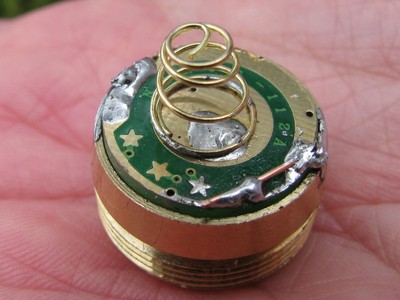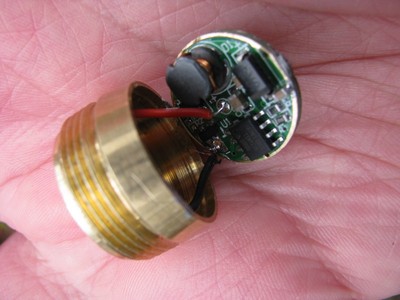Driver Swap
One of the key components of a flashlight is the driver, which is the electronics between the battery and the LED. The primary function of the driver is to regulate the voltage going to the LED. So if you have a 1.5V battery, the driver will increase the voltage to the 3.6V or so that a LED needs. If there are 2 3V batteries, a driver is needed that will reduce the voltage from 6V so that they won't blow out the LED. But drivers can also give different light levels or provide strobe and SOS modes.
Not long ago I bought a flashlight that uses P60 drop-ins. The advantage to that kind of light is it uses a bunch of standardized parts that can be swapped out. So of course I was on the lookout for some kind of modification (or "mod") I could do to the light. It is a good light, but comes with 5 modes by default (High, Medium, Low, Strobe, SOS) and always comes on in High. Really I would rather have a 2-mode or 3-mode light that would remember what mode it was in last. If you want Low, it stays in Low until you change it. Well, obviously all I would need to do is find a new driver.
There are hundreds of drivers it seems like. But one of them was intriguing to me because it offered several different sets of modes that could be selected by soldering on some jumper wires onto the circuit board. By default, the light comes with 5 modes and is designed to take up to 4.2V. That works fine since I keep a 3.6V lithium-ion battery in that light and it is 4.2V when fully charged. But if you solder a wire from ground to the first of four star-shaped pads on the back of the driver, it becomes a 2-mode driver with High and Low. Extend that bridge to the second star and it becomes a 3-mode driver with High, Medium, and Low. And it remembers the last mode. This seemed so neat I couldn't *not* buy it. It was only $5 so I bought one when I was buying another light that I had my eye on for a long time.
First I had to disconnect the old driver. There are two wires coming from the LED that connect to the driver board. I was able to melt the solder pad connecting the wire and it came right off without damaging anything. Then I had to find out where to attach those wires to the new driver and I found this post which some people said worked. That was tricky because this board is very small and already has a bunch of stuff crammed on it that could be damaged by a hot soldering iron. But I managed to get the wires soldered in securely to the right places. Because the driver board fits at the top of the battery chamber, it has a spring mounted to the bottom of it, so I had to unsolder the old spring and solder it to the bottom of this board which went pretty well too. Without messing with the stars, I wanted to test everything out, so I put the board in place, put the battery in and pressed power. Nothing. Either I had fried the board or one of the connections was bad. What I realized was that the board itself was not making good contact with the brass housing which carries the negative charge from the other end of the battery. Usually there is a glob of solder along the edge of the board to make this contact, so I added one and tried it out again. Voila! It worked. But it was five modes. So now I sat down and tried to figure out how to connect the stars. I looked for some wires I could stick in the little holes next to the stars, but the wires I had on hand were too big to go in there. Then I thought I could just put a big blob of solder in between the stars to connect them. But the green part of the circuit board is designed to resist solder, so I couldn't get a connection that way. Then I bent a wire in two to make a little jumper which was really hard to get on there.
Finally I straightened the wire and just laid it down across the stars and soldered at each star. That worked really well and had the advantage of being reversible. So I soldered two stars to get 3 modes. I tried it out but it seemed like I was getting Low-Low-High. I think the Low and Medium are just really close together. I had noticed this a little when it was on 5 modes too, but it didn't bother me then. Well, that is kind of pointless, so I rearranged the jumper to connect to only one star and converted it to two modes which works just fine. Really Medium just gets in the way anyway.
More info about this driver here.

